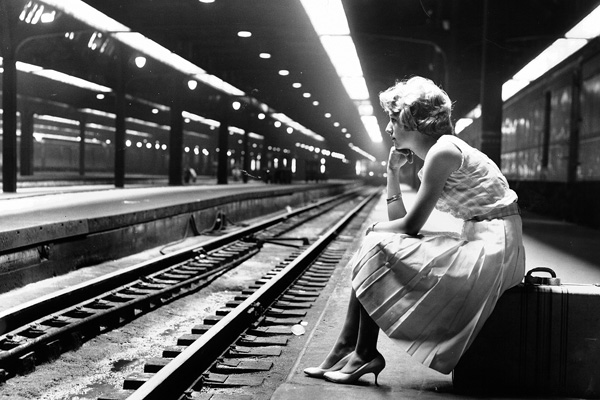
Photo: Chicago Tribune archive photo
16-year-old Ellen Schmitz of St. Louis waits for a train at Union Station, September 1, 1960
The other day I got stranded in Union Station for the first time in awhile, and had a chance—while sipping on a to-go red wine in a plastic cup—to think about what an odd space it is: perfectly functional, quite beautiful in places, heavily trafficked (118,000 passengers every weekday, 90 percent Metra), and kind of lifeless.
The Great Hall is one of Chicago's best public spaces, but it's also not so great, if that makes sense. Monica Reida captures it:
Unfortunately Union Station is not very inviting for passengers. While the headhouse is still a marvelous structure, there's something dispiriting about being in a facility that is usually very empty. The rest of Union Station, particularly the concourses where there's food, is dim and maze-like. The study also found that 58 percent of passengers felt the dining options were sufficient, and a majority of those feeling that way were Amtrak passengers. The long-term plans offered in the study seem promising, but due to cost it would be nice if a short-term solution had been offered up to make Union Station better for passengers who maybe have a layover.
The problem with Union Station was best summed up by my little sister, who frequently goes through Union Station when traveling between Milwaukee and Lansing, MI: "Dude, Union Station sucks."
Given the beauty of the headhouse, it's an odd place to suck. Yet it kind of does. (The one exception to food and drink being stuck in a bad-airport-like concourse is the transplanted suburban sports bar affixed to the Great Hall.)
So it was nice to see that the Metropolitan Planning Council is running a placemaking competition for Union Station, public voting on which begins today. Winners get $5,000 and the chance to create their place, for 10 days, beginning August 24. Let your conscience be your guide, but I'm into:
* Chicago At Play ("sets three pianos at intervals along the arcade, accompanied by educational posters that 'teach' one song each"), similar to Luke Jerram's "Play Me, I'm Yours" street pianos;
* StoryStation ("a carpeted area with bookshelves full of free books, tables for reading, and a central programming/information area. Users can feel free to read a book at the station or take one home to return later"), which parallels what you see in some of the suburban stations, but with cultural programming;
* Rush Hour Concert Series, for obvious reasons.
* And Pinball Hall, because pinball is awesome.
It's not that farfetched an idea—Philadelphia has used livestock troughs and mini golf to enliven its 30th Street Station.



